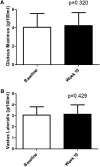The metabolic and endocrine response and health implications of consuming sugar-sweetened beverages: findings from recent randomized controlled trials
- PMID: 24228199
- PMCID: PMC3823516
- DOI: 10.3945/an.113.004580
The metabolic and endocrine response and health implications of consuming sugar-sweetened beverages: findings from recent randomized controlled trials
Erratum in
-
Erratum for Rippe. The metabolic and endocrine response and health implications of consuming sugar-sweetened beverages: findings from recent randomized controlled trials. Adv Nutr 2013;4:677-86.Adv Nutr. 2017 May 15;8(3):522. doi: 10.3945/an.117.015404. Print 2017 May. Adv Nutr. 2017. PMID: 28507017 Free PMC article. No abstract available.
Abstract
Fructose-containing sugars, including fructose itself, high fructose corn syrup (HFCS), and sucrose have engendered considerable controversy. The effects of HFCS and sucrose in sugar-sweetened beverages, in particular, have generated intense scientific debate that has spilled over to the public. This controversy is related to well-known differences in metabolism between fructose and glucose in the liver. In addition, research studies have often been conducted comparing pure fructose and pure glucose even though neither is consumed to any appreciable degree in isolation in the human diet. Other evidence has been drawn from animal studies and epidemiologic or cohort studies. Few randomized controlled trials (RCTs) have compared HFCS with sucrose (the 2 sugars most commonly consumed in the human diet) at dosage amounts within the normal human consumption range. This review compares results of recently concluded RCTs with other forms of evidence related to fructose, HFCS, and sucrose. We conclude that great caution must be used when suggesting adverse health effects of consuming these sugars in the normal way they are consumed and at the normal amounts in the human diet, because RCTs do not support adverse health consequences at these doses when employing these sugars.
Conflict of interest statement
Author disclosures: J. M. Rippe’s research laboratory has received unrestricted grants and Dr. Rippe has received consulting fees from ConAgra Foods, Kraft Foods, the Florida Department of Citrus, PepsiCo International, Coca Cola, the Corn Refiners Association, and Weight Watchers International.
Figures




Similar articles
-
Sucrose, high-fructose corn syrup, and fructose, their metabolism and potential health effects: what do we really know?Adv Nutr. 2013 Mar 1;4(2):236-45. doi: 10.3945/an.112.002824. Adv Nutr. 2013. PMID: 23493540 Free PMC article. Review.
-
Twenty-four-hour endocrine and metabolic profiles following consumption of high-fructose corn syrup-, sucrose-, fructose-, and glucose-sweetened beverages with meals.Am J Clin Nutr. 2008 May;87(5):1194-203. doi: 10.1093/ajcn/87.5.1194. Am J Clin Nutr. 2008. PMID: 18469239 Free PMC article. Clinical Trial.
-
Energy and fructose from beverages sweetened with sugar or high-fructose corn syrup pose a health risk for some people.Adv Nutr. 2013 Mar 1;4(2):220-5. doi: 10.3945/an.112.002816. Adv Nutr. 2013. PMID: 23493538 Free PMC article. Review.
-
High-fructose corn syrup and sucrose have equivalent effects on energy-regulating hormones at normal human consumption levels.Nutr Res. 2013 Dec;33(12):1043-52. doi: 10.1016/j.nutres.2013.07.020. Epub 2013 Aug 30. Nutr Res. 2013. PMID: 24267044 Clinical Trial.
-
Effects of high-fructose corn syrup and sucrose consumption on circulating glucose, insulin, leptin, and ghrelin and on appetite in normal-weight women.Nutrition. 2007 Feb;23(2):103-12. doi: 10.1016/j.nut.2006.11.001. Nutrition. 2007. PMID: 17234503 Clinical Trial.
Cited by
-
Beverage Intake Assessment Questionnaire: Relative Validity and Repeatability in a Spanish Population with Metabolic Syndrome from the PREDIMED-PLUS Study.Nutrients. 2016 Jul 30;8(8):475. doi: 10.3390/nu8080475. Nutrients. 2016. PMID: 27483318 Free PMC article.
-
Fructose consumption in the Netherlands: the Dutch National Food Consumption Survey 2007-2010.Eur J Clin Nutr. 2015 Apr;69(4):475-81. doi: 10.1038/ejcn.2014.267. Epub 2014 Dec 17. Eur J Clin Nutr. 2015. PMID: 25514900
-
Sweeteners and health: findings from recent research and their impact on obesity and related metabolic conditions.Int J Obes (Lond). 2016 Mar;40 Suppl 1:S1-5. doi: 10.1038/ijo.2016.7. Int J Obes (Lond). 2016. PMID: 27001641 Review.
-
Fructose Metabolism and Relation to Atherosclerosis, Type 2 Diabetes, and Obesity.J Nutr Metab. 2015;2015:823081. doi: 10.1155/2015/823081. Epub 2015 Jun 14. J Nutr Metab. 2015. PMID: 26199742 Free PMC article. Review.
-
The effect of normally consumed amounts of sucrose or high fructose corn syrup on lipid profiles, body composition and related parameters in overweight/obese subjects.Nutrients. 2014 Mar 17;6(3):1128-44. doi: 10.3390/nu6031128. Nutrients. 2014. PMID: 24642950 Free PMC article. Clinical Trial.
References
Publication types
MeSH terms
Substances
LinkOut - more resources
Full Text Sources
Other Literature Sources
Medical

